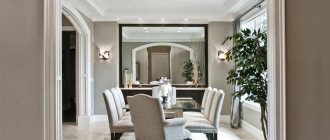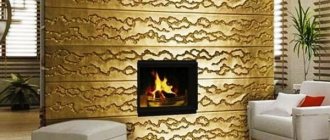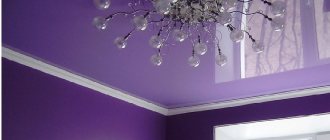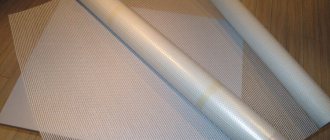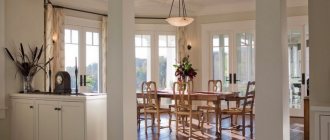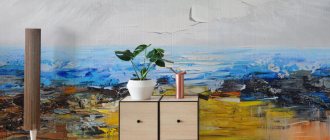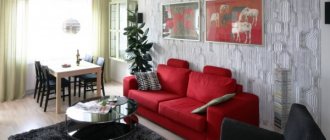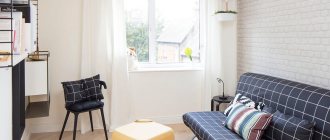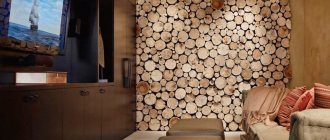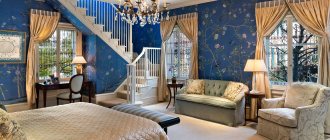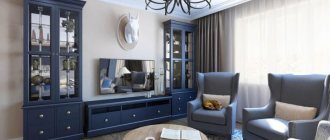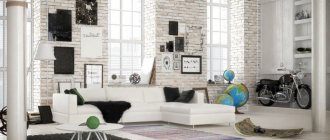A family's provision of living space is one of the most important indicators of living standards. However, it does not reflect the quality of living conditions, which many want to improve. Trying to correct the problem, some owners carry out major renovations in their home, during which issues are raised about moving walls and dividing a single space in a large room into several functional zones. At the same time, it is necessary to solve a number of problems related to both the coordination of documentation and the choice of material for installing new fences. They can be built from brick, foam block, plasterboard, or use glass blocks for partitions. Let's look at the last of the listed building materials in more detail.
Pros and cons of glass blocks in the interior
- decent sound insulation;
- higher light transmittance;
- strength and reliability of constructed structures;
- complete protection from moisture;
- environmental friendliness, dust protection;
- fire resistance and resistance to extreme temperatures;
- unpretentiousness in sanitation and inertness to aggressive chemical and biological environments;
- protection from prying eyes;
- thermal insulation ability;
- versatility in finishing external premises and external facades;
- improved combinatorics: from shapes, sizes, colors and interior design;
- constructive possibility of arranging niches;
- variability: there are options with an acceptable price “for an average portfolio”;
- a plastic block with significantly less weight can be considered a replacement;
- original, elegant and presentable appearance in the interiors of various rooms.
Along with an impressive list of advantages, one can also identify disadvantages.
- Complexity of installation, requiring certain professional skills.
- The weight of the block is impressive, so experts recommend using an area of no more than 15 square meters for glass blocks. Being lighter, plastic does not withstand significant mechanical loads.
- The glass surface is not suitable for finishing with nails, screws, or dowels.
- Cutting glass blocks is contraindicated. You will have to fully comply with the specified parameters of the source material.
- It is impossible to carry out utilities and electrical wiring inside the blocks.
- Glass material with voids, such as windows, will not allow air to circulate in the room, creating the necessary ventilation in living spaces.
What is glass block and how does it work?
Glass blocks are two square glass boxes welded together with sides. Inside there is emptiness, or rather highly rarefied dry air. Dust and condensation cannot fall into the interior of the block, so the glass walls of the block always remain transparent from the inside.
As we know, sound waves, as well as a significant proportion of heat, are transmitted by vibrations of air molecules. Accordingly, the discharged space inside the block does not transmit sound well. The absence of air also prevents the transfer of heat, giving the glass block thermal insulation properties no worse than even double-glazed windows.
True, it would not be entirely correct to say that glass blocks are transparent; their walls transmit about 70% of the light flux. But, now, it will no longer be possible to see anything behind their thick corrugated surface, except for blurred silhouettes.
Glass blocks are suitable where you need to provide good natural light, while at the same time hiding what is happening behind the wall.
Another advantage of glass blocks is their high fire resistance. Thick glass can burst only from a sharp and strong temperature change, but is practically invulnerable to relatively uniform heating even from a strong fire.
Openings filled with glass blocks sometimes resemble exquisite stained glass windows
The aesthetic qualities of modern blocks are noticeably superior to their Soviet predecessors. Today they are produced in a variety of colors and shades, decorated with various designs. Various decorations and unusual objects are placed in the internal voids of the blocks. There are a great variety of design options for both the glass blocks themselves and the design using them.
Where are glass blocks used?
Glass blocks are distinguished by good sound-proofing and heat-saving properties, increased resistance to moisture and other external factors.
Application of material:
- For wall decoration or decorative inserts.
- To create partitions by dividing the room into functional zones.
- For finishing external walls of residential premises.
- For zoning the bathroom, finishing the walls of shower corners.
The variety of surfaces, shapes and colors of glass blocks allows this material to be used for interior decoration in different stylistic directions.
Most often, glass blocks are used to decorate the bathroom. The material is practical, resistant to high humidity, easy to maintain, more reliable and durable than drywall. Glass block walls are suitable for decorating a shower stall.
In combined bathrooms, the material can be used to divide a spacious room into functional zones. A straight or round wall made of multi-colored or plain glass blocks can be used to decorate a shower stall or staircase.
You can also create a small partition between the bathroom and the bathroom. In a large room, the washing machine can be separated from the main compartment, creating a small room for washing and storing clothes.
In the bathroom of a country house, you can cover the window with glass blocks with colored patterns or stained glass; when exposed to sunlight, the window looks interesting and unusual. Partitions and walls made of glass blocks are very strong, but they cannot replace load-bearing walls.
In the kitchen
Glass blocks are used more often in creating kitchen interiors. Glass material is used not only for finishing walls, window and door openings, but also for finishing a kitchen apron, decorating and zoning a room.
Wall decoration with glass blocks Source roomester.ru
Recently, glass blocks have been used to make table bases. This decor looks quite interesting and unusual.
Clear glass blocks pair well with white kitchen cabinetry or wood trim.
Wall decoration with glass blocks Source homester.com.ua
Types of glass blocks
Experts qualify them according to the following criteria: size, color palette, texture, shape, glass strength, load resistance and visual characteristics.
Dimensions
Today there are a large number of glass blocks of different heights and widths. Most often you can find sizes from 190x190x80 mm. Do not clutter a small room with too large partitions and massively fill the space with small ones. In the case of finishing, it is necessary to maintain visual harmony of the room and the decorative material.
Color palette
The number of shades is increasing every day. Every color of the rainbow can be found on sale. The most successful shades that fit perfectly into almost any design are white, blue and transparent.
Surface texture
It is this property that affects the rays of light passing through the glass block. There are such popular surface options: smooth, wavy, matte, glossy, transparent, patterned.
Form
Most often on sale you can find such variations in the shape of glass blocks: square, rectangular, triangular, with a rounded edge, round, oval, hexagonal.
Glass strength
It can vary from 5 to 7 mm. The thickness of the material also affects its weight, which is 2-5 kg.
Load resistance
This feature may depend on the desired structure of the glass block inside. This can be an impenetrable partition or a delicate decorative structure.
Visual characteristics
Optical and aesthetic properties include not only color and shape, but also the degree of light transmission, the shape of the glass and the nature of the light flux (can be bright, directional or diffuse).
Material characteristics
Glass blocks can be classified according to several parameters. First of all, attention should be paid to the country in which the product was manufactured. On the construction market you can find German, Italian, Czech, Polish, Russian, and Chinese products. They all have the same design, their dimensions are the same. The only difference is quality and price. In addition, all blocks differ from each other in the following ways:
- shape and dimensions;
- glass thickness;
- texture, color and filling;
- strength and resistance to stress;
- optical characteristics;
- scope of application.
Basic dimensions, shapes and structure of the block
To understand the structure of a glass block, just look at its definition. It follows from it that a block is a product obtained by connecting two pressed glass plates, between which a hermetically sealed cavity is formed. According to GOST 9272-81 clause 2.4, the thickness of the front walls should be more than 8 mm. Here in clause 1.1 in Table 1 the standard dimensions and weight of the finished product are indicated.
According to the GOST discussed above, glass blocks can have a square or rectangular shape. The size of the first should be (length, width, thickness, in mm) 194x194x98, 244x244x75 and 244x244x98 with a mass of 2.8, 3.8 and 4.3 kg, respectively. The second - 294x194x98 mm weighing 4.2 kg. Upon agreement with the consumer, it is allowed to reduce the length and width by 10 mm downwards.
Manufacturers offer a wide range of finished products, which may have non-standard dimensions. It all depends on the form. The smallest products are 115x115x80 and 60x146x80 mm, and the largest are 300x300x100 mm. Triangular models are available in only one size: 172x172x236x80 mm. But the most important thing is that all countries that produce designs adhere to the same standards.
The standard type of products is square and rectangle. There are also more sophisticated models in the form of a triangle, rectangle, circle, hexagon, L-shaped, with rounded side edges. There are also exclusive options that are made according to individual sketches to order; special matrices provided by the manufacturer of figured glass blocks are used for their installation.
Color variety and matting
All glass blocks can be divided into transparent and colored. Referring to GOST 9272-81, you can understand that products can be painted or unpainted. The first of those listed according to clause 2.1 may have a yellowish, bluish, greenish tint, which do not reduce the light transmittance. Clause 2.3 states that the color and relief pattern must correspond to the reference samples.
Based on the color palette, you can distinguish between colorless and colored models. In addition to the standard colors of green, yellow, red, blue, you can find bricks on sale in a huge range of shades. Coloring is done in two ways. The highest quality products that are not afraid of temperature changes and sunlight are obtained by adding coloring substances to the glass mass before molding begins.
Glass blocks, which were made of transparent glass, painted in the vacuum part (from the inside), are used exclusively inside heated rooms. Under the influence of ultraviolet radiation or as a result of a sharp change in temperature, the paint begins to crack, fade, and fade. When choosing a specific model, it is worth considering the fact that multi-colored blocks transmit light worse.
Matte structures have a light transmittance of 30-50%. Thanks to the diffusing effect, they create a greater degree of protection, so they are used in rooms with unwanted access to light from the outside. Semi-matte options are blocks in which one side is matte and the other is normal. A partition made of such bricks visually appears to be illuminated from the inside.
Special purpose
Depending on the scope of application, all glass blocks can be divided into industrial, interior and decorative models. The former are characterized by increased strength, water resistance, and fire resistance. This is the cheapest type of glass brick. They are used in production workshops, public institutions and institutions, when organizing staircases, and for other purposes.
Interior blocks are used for finishing residential and office premises, although they can also be used in the exterior. This is the most popular material that maintains a balance between price and quality. Glass blocks are characterized by a wide variety of shapes, sizes, colors and textures. They are used to construct partitions, windows, floors, make inserts into walls, and even furniture, for example, lay out a bar counter.
Decorative models contain various patterns and designs. The objects placed inside can be shells, pebbles, toys, replicas of fruits, ship models, etc. This is the most expensive type. Most often they are used as an addition to conventional glass blocks. To decorate a space and emphasize a certain design, a few bricks are enough.
Application options
Glass blocks are used to solve a variety of problems: from zoning to decorating space.
Partitions
The construction of walls can be useful in offices, for example, to highlight a sleeping area in an open space or to clearly separate the space for cooking and relaxation. Glass block partitions in the bathroom are often equipped with shower stalls.
The design of partitions made of glass blocks looks advantageous both alone and in combination with other materials - they are sewn into drywall, creating original light windows or rows.
When it is necessary to build a large wall, glass is combined with brick and concrete blocks, as it itself looks too cold, like ice chips.
Window
Glass blocks are used to decorate interior windows of residential premises or exterior windows in private homes, in bathrooms, to hide from the prying eyes of neighbors.
For example, by installing glass blocks instead of a transom between the bathroom and kitchen, you will get decorations and additional lighting at the same time. And by cutting an opening in the white wall between the living room and the bedroom without windows, you will make the relaxation area more comfortable due to the penetration of natural light.
Furniture
The material is so versatile that glass block furniture is often made inside kitchens! They serve as a stand under a table or bar counter. Add lighting to the glass and get a modern and original decoration for your kitchen space.
Apron
A glass apron over the tabletop is not only practical, but also aesthetically pleasing. The surface is easy to clean, is not afraid of water, grease, high temperatures, and transmits light: in general, in all respects, it is suitable as a substitute for tiles or leather.
Decorative inserts in the wall
Glass bricks are used in wall decoration when there is a need to use this unusual material to a limited extent. Squares, like pixels, can be assembled into any shape - from abstract to completely recognizable. If desired, you can build in a backlight that acts as a dim evening light or a night light.
Advantages and disadvantages
A glass block can be called a kind of hollow brick, which, unlike the original, is made not from clay, quartz sand or limestone screenings, but from glass. The material is widely used in construction, due to a number of useful properties inherent in the finished product. Among the main advantages of the products under consideration are the following aspects:
- Strength. The building material is almost impossible to break. It withstands mechanical loads, including impact and compression.
- Durability. The service life is at least 15 years. At the same time, the products are not afraid of direct sunlight; even painted versions will not lose their original appearance under the influence of ultraviolet radiation.
- Range. Manufacturers produce a wide variety of blocks that differ in shape, size, surface texture, and have a wide range of colors. This allows you to bring to life any design ideas, both when creating the exterior and when organizing the interior.
- Scope of application. Glass blocks are used in the chemical and food industries, in medical institutions, in laboratories, in the construction of private houses, public buildings, and in other areas.
- Easy care. Ready-made structures are easy to maintain. Glass does not absorb dirt and is inert to chemicals. Dirt is easily removed from the surface. Dust cannot enter the internal cavity.
- Light transmission. Glass elements allow light into the room well.
- Easy installation and dismantling. You can erect a partition from glass blocks with minimal construction skills, and to replace a damaged element you do not need to completely dismantle the masonry.
- Noise insulation. Glass blocks have good sound insulation characteristics, which allows them to be used in load-bearing walls.
- Moisture resistance. Glass is not afraid of moisture, it does not absorb water, it is not afraid of condensation, which is why the material is used in the construction of partitions for bathrooms.
- Fire resistance. The products are classified as non-flammable substances. Able to withstand exposure to open flame for an hour.
- Heat resistance and frost resistance. The blocks can withstand differences of up to 40 °C, and a temperature range from – 40 to + 500 °C.
- Thermal insulation and energy saving. They retain heat well inside the room, which allows you to save on heating costs. In hot weather, hot air is not allowed in, keeping the room cool.
- Environmental friendliness. Natural ingredients are used in production, which ensure the environmental purity of the product.
The disadvantages of glass blocks include:
- Complex processing. The block is difficult to cut into pieces. It is almost impossible to make a hole in it; under pressure it can burst.
- Heavy weight. Partitions assembled from these bricks significantly increase the weight of the entire building structure as a whole.
- Breathability. The material does not allow air to pass through. This must be taken into account when arranging a window opening, and consider the method of ventilation.
- Price policy. Finished products are expensive compared to other building materials used for construction and finishing.
In what styles is it appropriate to use
The excellent properties of glass blocks and a huge variety of colors allow you to realize the most daring design ideas. Using the material, you can create interesting compositions that complement the interior, decorated in a modern style, such as high-tech, urban, pop art, constructivism, loft, modern. Stained glass models are ideal for the Art Nouveau direction, which would also be appropriate in oriental stylizations.
In classical directions, it is better to avoid glass blocks. Classicism does not tolerate such a combination, this applies to Baroque, Renaissance, Empire and others. In addition, the material will look inappropriate in an interior decorated in a rustic and natural style, for example, eco, country, Provencal, chalet, rustic. If you do not have professional knowledge, it is better not to take risks and turn to experienced designers.
Limitless design possibilities
Most often you can find glass blocks in the bathroom or kitchen. In the interior of a children's room, bedroom or living room, they are used less often, more as a decoration than a functional element.
The main features of glass blocks that attract designers:
- Decorative glass blocks are capable of transmitting more than 80% of sunlight, while at the same time allowing you to create a barrier behind which you can comfortably retire. This is true for small rooms;
- Glass and plastic blocks are particularly resistant to moisture. These qualities will be useful in residential apartments and houses (bathroom, kitchen, dining room), as well as in public places (dining rooms, saunas, beauty salons, swimming pools);
- The structures are very durable and comfortable to use;
- Glass blocks in the interior of a bathroom or kitchen look organic and fit well with any design and other materials in the apartment;
- A shower cabin made of glass blocks, glass partitions, compositions in door or window openings are very durable, they are convenient and easy to care for;
- Excellent sound insulation (for example, glass blocks will muffle the sound of pouring water by 60-80%);
- Good thermal insulation properties.
Using glass blocks in the interior of rooms
Excellent sound-absorbing material is often used as decoration and decoration of rooms. With their help, you can play up any corner of the room, disguise the disadvantages of the layout and highlight the advantages. Glass blocks of any type and design have excellent heat-saving properties and are resistant to moisture. Translucent cubes are suitable for creating partitions, original shelves, and window openings. When choosing suitable elements, you should take into account the purpose of the room, its design and size.
In the kitchen
Most often, glass blocks are used to divide space in the kitchen. A beautiful matte wall in the color of the finish will be a good solution for separating the dining room and the food preparation area. The practical design of the squares themselves is easy to clean, does not absorb odors and retains an attractive appearance for a long time.
When choosing such partitions for the kitchen, you should understand that they can serve only a decorative function. It will be impossible to load them with decorations, furniture, or mount heavy structures on them.
In the living room
Practical modern materials can be used to create fantastic furniture that will become a real work of art. Glass squares are installed along one of the walls of the living room, along the perimeter of the windows, next to the interior partition. The highlight of the interior will be multi-colored blocks arranged according to the planned pattern.
A partition in the form of translucent bricks of different textures will look beautiful in the hall or corridor. Rainbow details will create an atmosphere of comfort and provide good sound insulation. Colored elements can also be installed near the window, since glass blocks transmit 90% of the sun's rays and do not cover the space.
In the bedroom
Translucent partitions in the relaxation room will create an atmosphere of relaxation and relaxation. The best effect can be achieved by using warm shades, regular geometric shapes and special lighting for decoration. In large rooms, glass blocks can be an excellent solution for zoning. They serve to separate the sleeping area from the reading room and to enclose an elegant dressing room.
By installing a partition made of colored squares near the bedroom window, you can achieve soft diffused lighting and suppress excess noise from the street. It will be pleasant to be in such a room at any time of the day.
In the nursery
A wide selection of textures allows you to use glass blocks in a children's room. To decorate the room, choose multi-colored squares and rectangles. You can choose products with unusual effects that create the feeling of a fairy tale.
In the nursery, a multi-colored panel with cartoon characters sealed inside each element will look original. Low block structures are used to divide the space, fence off the recreation area from the play area and install lamps nearby.
In the bathroom and toilet
When decorating a bathroom or cabin with glass blocks, they can be used in different ways. Design methods can be combined or applied to a specific one. For dark walls, a real solution would be to finish the surfaces with squares with transparency. This way you can reduce energy costs and effectively divide the bathroom.
If you replace one of the walls or part of it with glass block decor, you can visually expand the space. Due to the penetration of light from neighboring rooms, lighting will significantly improve. In small rooms it is better to use details of the same texture and color.
Installing glass block partitions in an apartment is an ideal solution for a bathroom, toilet, or shower. Translucent details do not restrict space; they do their job well. They can be used in either an adjoining bathroom or a separate bathroom. The blocks are assembled in continuous rows or combined with plasterboard, brick, or wood.
In the bathhouse and sauna
Decorating these rooms with glass partitions will make them original and unique. In this case, all functions that define a bath or sauna will be observed in accordance with generally accepted standards. The main useful characteristics of block finishing include water resistance, resistance to extreme temperatures and excellent thermal insulation.
Glass blocks are often used as partitions, delimiting shower and sauna areas. Decorating the walls with such elements will also be an excellent solution, since they take up much less space than other options made from other materials.
In the hall
Glass blocks in the corridors serve as a separator between the entrance group and the living part of the room. The walls are made blank or with windows, where it is convenient to place vases, figurines and other decorations.
By replacing concrete or brick walls with glass (while you're tearing down the non-structural structures!), be sure to let light into the hallway during the day and save on electricity costs.
On the balcony
They are used as in other rooms: they are divided into zones and they decorate furniture. It is better not to use it to replace windows, because the throughput of the beams is less than that of a double-glazed window.
See photos of using glass blocks in the interior of an apartment in the gallery - we have collected the most original and stylish solutions!
Glass wall blocks for creating partitions
Glass blocks are an inexpensive material that does not require additional cladding. Due to this property, it is often used for the rapid modernization of old buildings or the construction of demountable structures.
An excellent translucent material for secondary walls, false windows, partitions and piers. A window opening made from “halves” of cubes near a jacuzzi or bathtub will serve as additional niches for bath accessories and shampoos. Using cubic elements, you can create a window sill space between the attached balcony and the living room with your own hands if you are not satisfied with the result of the redevelopment.
An updated approach to design projects in houses and apartments without walls - partitions made of cubes of different heights (bathroom or toilet). The upper edge can be stepped, the partition itself can be hemispherical or angular. Use your imagination.
You can lay out the wall up to face level to observe everything that is happening in the house while taking a shower. This is true when there are several children or playful pets in the house.
Glass blocks are an inexpensive material that does not require additional cladding.
Original solutions in a modern interior
Glass windows and partitions will no longer surprise anyone. But using this durable yet translucent building material as a base for a floor can bring originality to any interior. Here is just one way to decorate an office with a seating area. The glass roof and glass block floor made the room feel airy, light and airy.
A semi-circular bar counter made of translucent glass blocks? Easy! The design will look especially impressive if you add colored or monochrome lighting to the design.
Small glass block inserts in the walls are a unique opportunity to add originality to the interior of the room. The room is filled with light, reflections play on the surfaces, but the walls do not lose strength and wear resistance.
Creating an internal partition from transparent glass blocks in the staircase space will help create a light, almost weightless image of this structure. The durable design will protect your staircase from direct sunlight from neighboring rooms.
Unusual use of glass blocks is also found in the sleeping area. Windows made from this material can protect your space from prying eyes, but at the same time fill the room with soft sunlight.
In the hall
In most cases, hallways have a small area; to visually enlarge the space, you can use light shades in the interior or decorate the corridor with glass blocks.
The door to the living room can be replaced with a beautiful arch made of glass blocks.
The floor and ceiling can also be finished with a strong material, such as blue. You can make a small table from glass blocks near the wall.
Floor and ceiling made of glass blocks Source lboz.ru
Adding glass blocks to your wall trim can help improve illumination in a poorly lit hallway.
Wall decoration with glass blocks Source roomester.ru
More photos of glass block ideas
External surface
Modern glass blocks can have a flat and smooth surface, this will increase the light flux passing through it. On sunny days, your room will be illuminated by pleasant sunshine.
There are also options with decorative motifs or matte surfaces. Thanks to this, you can create an interesting interior from glass blocks in an apartment or private house.
Main types of surfaces:
- Smooth transparent;
- Mirror shine;
- Opaque;
- Simulated.
Which glass block manufacturers are best to choose?
The correct choice of glass blocks is an important point when assembling a decorative structure. The range of such elements is varied. You can purchase products from domestic, Czech, and Italian manufacturers. Each glass block option will have special characteristics:
- Domestic. Affordable price and high quality make such parts the most popular on the market.
- Italian. They stand out for their special difference in color tones from other manufacturers. All blocks have perfectly precise lines.
- Czech. They occupy a leading position in production. They are distinguished by a wide variety of designs and unique colors.
Creation of furniture items
Glass blocks, due to their strength and at the same time small thickness, are an excellent material for creating stationary furniture. Original dining and coffee tables, various designs of bedside tables and bar counters, separating, for example, the kitchen area from the living area in a studio apartment.
Such furniture looks even more impressive in combination with various lighting options.
Formation of window openings
Often, interior windows in apartments and houses are formed using spectacular glass blocks. They give lightness and airiness to the walls and allow better dispersion of the sun's rays.
Particularly noteworthy are the illuminated designs, which look great in the design of living rooms, bedrooms and hallways.
Do-it-yourself technology and methods of installation
There are several ways to attach glass blocks. Choose the appropriate option based on the size of the partition itself. It should be understood that the elements cannot be cut, so before purchasing materials you need to study the products of different manufacturers. For decorative blocks with a pattern, you will first need to make a pattern, according to which you will later arrange all the elements on the floor.
Frame
The method is suitable for creating light and small structures. Most often these are half partitions for zoning. The strength indicators and soundproofing qualities of the structure in this case will be much lower than when assembled using other technologies.
The main advantage of assembling glass block frames is aesthetics. Another advantage is the ability to replace elements and clean operation. A wooden frame is used as a base. The design of the cell resembles a lattice or shelving in size of the glass parts.
First of all, the frame is attached to the base. It is screwed to the floor, to the wall with dowels or anchors. Special rubber gaskets are placed on the glass blocks, which are inserted into the cells of the frame or staircase. To add strength to large structures, sealant is used.
If you need to give a wooden structure a certain color, you need to paint it in advance.
For solution
Cement is used as an adhesive mixture. It should be uniform, without large grains of sand that can scratch the glass. You will also need to purchase crosses to establish a fixed distance between the blocks and add rigidity. Reinforce the glass wall with metal rods.
After laying a series of glass elements, a new layer of concrete is applied and the metal rod is laid horizontally. If the structure area is large, then additional metal supports are installed vertically. It is recommended to install no more than three rows of glass blocks at a time. To prevent the structure from falling apart, the cement mixture must be allowed to dry for at least a day.
On glue
A wooden frame is used as a base. It is cleaned of debris, dust and the main marks are applied. To determine the required distance on the panel, arrange the blocks and plastic dividers. Then the length and height of the future structure are measured, and the dimensions of the frame are calculated. If in the future it will be attached to the wall structure, holes must be drilled in certain places.
To install transparent elements, white tile adhesive is used. This way the seams will be more aesthetically pleasing, and the likelihood of the part being stained is minimal. First, they check the integrity of the glass blocks, because manufacturers guarantee the quality of the elements only until the moment of their installation. They are then laid in rows, placing reinforcement to support the strength of the structure.
It is not recommended to remove the protective film from glass blocks during installation. This will help protect them from damage. If it is not there, you should stick polyethylene on it, securing it with paper tape.
Installation of glass block partitions
Creating structures from glass blocks is a simple process. Installation of glass block partitions includes the following steps:
- Determining the installation location of the partition.
- Preparing and cleaning the mounting surface. Using slats, you need to outline the boundaries of the base of the structure.
- Laying the first row of glass blocks.
- Installation of stainless steel reinforcing rod. It is not recommended to lay more than 3 rows of blocks per day, as the structure may warp.
- After the mixture has completely dried, you need to remove the crosses and protective film on the blocks and begin applying the grout mixture.
- After cleaning the partition and drying it completely, it is necessary to protect the structure from moisture by applying a waterproofing liquid.
Glass blocks in a modern interior Source www.gradnja.rs
How to use glass blocks in home design
Walls and partitions are the most common type of application of building and finishing materials, which have become universal. For this purpose, it is as durable as possible, soundproof and moisture resistant. Translucent architectural structures inside the dining room, bathroom, and toilet are considered the most successful and practical.
Partitions allow you to divide the learning space into zones, and walls allow you to delimit semantic zones. For example, separate the bathroom from the toilet. Uniqueness and originality are achieved through the use of blocks of various colors and configurations in the design. In the kitchen, glass blocks look attractive when decorating a bar counter or island in the form of stylized partitions.
Shower cabins are often made with semicircular partitions. Glass blocks do not let drops of water through and do an excellent job with high lighting: the penetration of natural light and the creation of an intimate environment, closed from prying eyes. Installed inside blocks made up of decorative elements “simulating an aquatic environment,” additional lighting will make the structures “alive” and original.
Double-glazed windows are most often used in technical rooms. These include, upon prior reservation, service premises - a bathroom and a toilet. Instead of a “blank wall”, a translucent window made of blocks in a private house is not only a bold, but also a practical and original solution. No additional curtains or blinds are required here. At the same time, the sizes and configurations of window openings can be of the most complex shapes, different geometries and locations on the wall.
“Unexpected” solutions in using glass blocks in the interior:
- a semicircular island table with lighting that serves as a bar area and dining area;
- fragmentary wall inserts made in a “chaotic” but thoughtful design manner;
- the floor and roof of a private house made of durable glass block will make an office, greenhouse, winter garden, attic unique;
- table made of glass blocks on a rigid frame for the strength of the entire structure.
Types and features of material
So, what kind of finishing material is this and what do glass blocks generally look like in the interior? To put it simply, it is a kind of hollow inside “sandwich” made of two thick centimeter glasses combined with each other. In the Soviet Union they were produced according to standards that have smoothly migrated to the present day. There are only two size ranges: 19x19x8 and the second - larger - 24x24x8.
The indicators remained the same:
- “filling” of air makes it possible to get rid of external noise in the room by almost 70%;
- they perfectly transmit light, leaving what is happening inside the house closed from prying eyes;
- In terms of strength, this tile can be compared to a brick; it conducts heat better than its counterpart, but one piece weighs significantly more than a brick - up to four kilograms.
What has undergone significant changes today is the appearance of tiles. Only the lazy cannot find a design and shape to suit their taste on the market today: with a pattern and in plain colors, with and without backlighting, in the form of stained glass or installations, decorated with flowers, corals and whatever your heart desires. Choose and conquer.
The form has also undergone significant changes. Today you can find not only classic rectangles and squares, but also triangular and even round options.
6 photos
Instagram @Elena_Kokotova_interior
Instagram @creative_viva
Instagram @buyndesign
Instagram @getino_design
Instagram @creative_viva
Instagram @remelle_spb
General tips for using glass blocks in the interior of an apartment
- To prevent the living room from turning into an office, add a little color to the interior.
- Decorate the space with blocks, add metal, wooden parts or fabrics - for example, a carpet will look very cozy.
- Ideal for using glass blocks inside the bathroom. You can even make an entire partition for the shower. See for yourself: this finishing material is perfectly waterproof, does not darken the space, and “removes” the sound of water. And if you add colorful details, lighting and nautical decorations to the inside of the block, it will look absolutely stunning.
- Professionals believe that the total number of glass tiles for all other materials should be approximately 1 in 10. Stick to this rule: excess is never in anyone's hands.
- Under no circumstances should the load-bearing walls of the house be replaced or individual squares included in such structures. The glass inside is decoration and beauty.
- Do you need to delimit several active zones in a room? A translucent wall is ideal for this.
In the living room
Glass blocks in the living room interior can be used to create full-fledged partitions.
Glass blocks in the bedroom interior Source remontbp.com
The use of glass elements in wall decor looks very interesting, stylish and unusual.
Decorating walls with glass blocks Source HappyModern.RU
The material is used to construct the base of a small coffee table or a full-fledged dining table.
Glass blocks in the living room Source remontbp.com
By decorating the walls with glass blocks, you can highlight the necessary area in the room.
